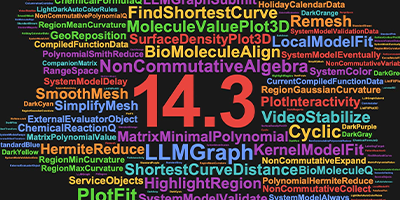Wolfram News Roundup: Neural Net Connectivity, Gravitational Wave Discoveries and More

It’s been an exciting beginning to the new year here at Wolfram Research with the coming release of Version 11.3 of the Wolfram Language, a soft announcement of the Wolfram Neural Net Repository and our launch of multiparadigm data science.
As part of the new year, we’re also launching some new content in the Public Relations department. As you may have seen, each month we are highlighting the accomplishments of our members on Wolfram Community. We are also recapping news and events about Wolfram each month. So, in case you missed the latest, check out these news stories:
“Apache MXNet in the Wolfram Language”

Taliesin Beynon and Sebastian Bodenstein in our Advanced Research Group recently authored a guest post for O’Reilly Media’s Ideas blog about the use of Apache MXNet in the Wolfram Language, providing a behind-the-scenes glimpse of a high-level deep learning framework.
“The aim of this post will be threefold: to explain why MXNet was chosen as a back end, to show how the Wolfram Language neural net framework and MXNet can interoperate and, finally, to explain in some technical detail how Wolfram Language uses MXNet to train nets that take sequences of arbitrary length.”
The post details what went into implementing MXNet connectivity in the Wolfram Language as part of the framework for neural networks and deep learning. Read more.
“Scientists Pioneer Use of Deep Learning for Real-Time Gravitational Wave Discovery”

Wolfram Research, NVIDIA and the National Center for Supercomputing Applications just announced breakthrough research in gravitational wave detection. Daniel George, Wolfram Summer School alum and a Wolfram intern, along with his coauthor Eliu Huerta, have published their work in Physics Letters B, outlining the use of deep learning for real-time gravitational wave discovery. Daniel used the Wolfram Language to build the deep learning framework called Deep Filtering. Read more.
“Sit Down at a Periodic Table That Holds Samples of Every Element”
Mental Floss published a piece about Theo Gray, cofounder of Wolfram Research and primary developer of the Wolfram Notebook interface way back in 1988. Theo is trained as a chemist and built the Periodic Table Table, which sits on the fifth floor here at Wolfram HQ. It is quite literally a table shaped like the periodic table, with slots for each element—even radioactive ones! Theo is also an accomplished author, and even has his hands in quilting at PaleGray Labs. Read more.
“A Train Station with Walls Designed Using Cellular Automata ‘Rule 30′”

Last summer, we noticed something peculiar. A train station in Cambridge, UK, was getting some attention on Twitter for its unusual facade. Keen observers noticed that the train station appeared to be clad with Wolfram automata. When our CEO Stephen Wolfram caught wind of it, he did some investigating in the Wolfram Language and quickly discovered that “oh my gosh, it’s covered in rule 30s!” He even prototyped a cellular automata architectural panel generator for users to build their own designs. Read more.
For more updates, be sure to follow us on Twitter, and you can also check us out on Facebook.



Comments